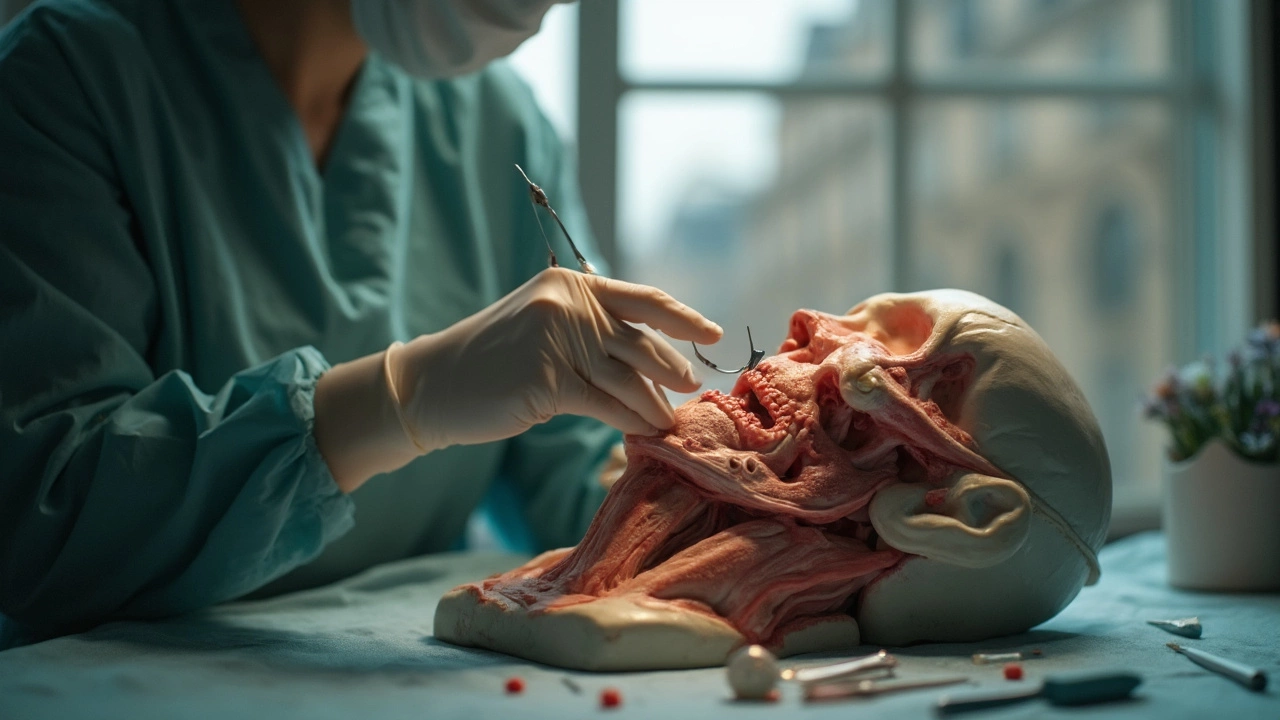Ever wonder which cosmetic surgery makes even the most experienced surgeons sweat? Spoiler: it’s not always what you see on reality TV. The hardest procedures aren’t about the length of the operation or the size of the change—they’re about the tiny details and how much trust you put in steady hands.
Surgery like rhinoplasty (yep, nose jobs) is a big contender. Why? The nose sits right in the middle of your face, where every millimeter counts. Get it wrong, and it’s instantly noticeable. Even revision nose jobs—fixing what went sideways the first time—are famously tricky. Surgeons often say it’s like working with scar tissue instead of fresh clay, and there’s zero wiggle room for mistakes.
But facial surgeries aren’t the only tough ones. Anything that reshapes complex body parts, or needs to look totally natural in daylight, takes the skill of an artist and nerves of steel. Sometimes, the challenge isn’t the cut—it’s getting your body to heal in a way that nobody would notice a thing ever happened.
- What Makes a Surgery Difficult?
- Surgeries That Really Test Surgeons
- Risks, Recovery, and Expectations
- Choosing the Right Surgeon in the UK
What Makes a Surgery Difficult?
So, what turns a regular cosmetic job into the hardest cosmetic surgery out there? It usually comes down to a mix of technical skill, risk level, and how much room you have for error. Some surgeries are tough because you’re working in a tiny space, like your nose or eyelids. Even one millimeter off can make a big, visible difference.
It’s not just about the size. Surgeons deal with complicated anatomy and loads of tiny blood vessels, nerves, and cartilage hiding under the skin. Cutting or stitching the wrong spot can mess things up quickly. That’s especially true in surgeries where it’s all about the fine details, like reshaping a nose or fixing a previous botched job.
Another thing that makes it tough is expectations. People want to come out of surgery looking natural—like their best self, not like someone else. That means the results have to blend in perfectly, even under bright lights or in selfies. There’s no hiding a bad facelift or crooked nose tip, especially now that everyone has cameras on them 24/7.
Lastly, healing adds another layer of challenge. Some surgeries can trigger more swelling, scarring, or complications just because of where they are or how much tissue was moved around. The body can be unpredictable; your immune system, skin type, or even how you sleep can change the end result. Top surgeons stay on their toes and adjust their approach for each person—no shortcuts.
Surgeries That Really Test Surgeons
Some surgeries make even long-time experts second-guess their breakfast. When people ask which procedures are most demanding, rhinoplasty almost always takes the crown. One tiny error can mean breathing trouble or an awkward bump staring everyone in the face. Surgeons say it can take years—sometimes over a decade—before they feel truly comfortable with this operation.
Another big one is facelift surgery. It’s not just about tightening the skin. Real skill is needed to reshape muscles and tissues underneath, so you end up looking refreshed, not like you’ve had work done. Mistakes can leave you with obvious scars or a stretched appearance. For patients over 50, surgeons need to be even more careful, since healing takes longer and the risks climb.
Breast reconstruction after cancer is another area where everything has to go just right. Here, the surgeon is rebuilding something totally new, often using tissue from another part of the body in what’s called a “flap” procedure. These surgeries can last 8 hours or more, and there’s lots that can make things tricky—like damaged blood vessels or the body's reaction to implants.
Here’s a look at some notoriously tough cosmetic surgeries and why they’re challenging:
- Rhinoplasty: Ultra-precise sculpting, breathing function, most ‘redo’ surgeries
- Facelift: Hiding scars, balancing symmetry, tricky tissue work
- Breast reconstruction: Rebuilding from scratch, high emotional stakes
- Body contouring after major weight loss: Managing extra skin, lots of stitching, longer recovery
These aren’t risky just for the surgeon’s nerves—patients can face a higher rate of complications or need touch-ups later. Getting it ‘perfect’ the first time calls for steady hands, tons of training, and a bit of artistry.
| Procedure | Years of Experience Recommended | Average Surgery Time (hours) |
|---|---|---|
| Rhinoplasty | 7–10+ | 2–3 |
| Facelift | 8–12+ | 3–4 |
| Breast Reconstruction (flap) | 10+ | 6–8 |
| Body Contouring | 8–10+ | 4–6 |
So, if you ever wonder why top surgeons can command fees that nearly match a small car, it’s because these high-difficulty jobs ask for both science and true craftsmanship. You’re not just paying for time on the table—you’re investing in years of fine-tuned experience.

Risks, Recovery, and Expectations
No one likes to think about what might go wrong, but being real about the risks and recovery is the smartest thing you can do before surgery. When it comes to the hardest cosmetic surgery, you’re looking at a combination of technical risks and what can happen after the operation.
Take rhinoplasty, for example. Common risks include breathing issues, infection, numbness, uneven results, or even long-term pain. If your surgeon’s not careful, a minor slip can completely change both how you look and how you breathe. Revision surgeries crank the risk even higher, mostly because there’s less healthy tissue for the surgeon to work with.
Recovery is different for everyone, but there are some tried-and-true facts. Swelling and bruising will stick around for weeks, sometimes months. Most people need about two weeks off work just for the bruises to settle down enough to not turn heads on the high street. But things like final nose shape or facial healing? That can take up to a year. Your patience will be tested, that’s for sure.
Here’s what you can do to make recovery smoother:
- Follow aftercare instructions from your doctor to the letter. They’re not just suggestions.
- Keep your head elevated and avoid strenuous activities—you really don’t want blood pressure going up around your face or surgical area.
- Avoid bumping or touching the area (seriously, don’t let Luna curl up on your chest while you’re sleeping—learned that one the hard way!).
- Eat healthy, get enough water, and listen to your body. The better you feel overall, the faster you’ll bounce back.
Expectations are a big deal, too. Some folks walk in thinking they’ll look red carpet ready in two weeks—reality? Not even close. Swelling can hide the final result for months, and minor imperfections sometimes appear when the swelling’s gone. That’s normal. Good surgeons won’t promise perfection, but they’ll give you a clear idea of what’s realistic for your face or body type. Ask them to show before-and-after pics of their own patients, not some polished gallery from the internet.
And don’t forget—mental health matters here. Some clinics have therapists or offer support groups for plastic surgery patients. If you feel stressed or have second thoughts while healing, it’s okay to talk about it. Honest expectations and solid recovery habits make all the difference in the end.
Choosing the Right Surgeon in the UK
If you’re thinking about going under the knife, finding the right surgeon in the UK can make all the difference—especially if you’re looking at the hardest cosmetic surgery procedures. You don’t want to guess; you want cold, hard facts and proof your surgeon's got the skills.
The first thing to check: credentials. Surgeons doing cosmetic ops here should be registered with the General Medical Council (GMC)—it’s not optional, it’s a must. On top of that, look for membership with the British Association of Aesthetic Plastic Surgeons (BAAPS) or the British Association of Plastic, Reconstructive and Aesthetic Surgeons (BAPRAS). These aren’t just fancy letters, they mean your doctor has extra training and experience in both the technical stuff and the art of making it look good.
Numbers say a lot. Did you know less than 40% of surgeons working in cosmetic clinics in the UK were on the GMC’s specialist register for plastic surgery as of 2024? Always double-check. If your surgeon won’t show you before-and-after photos or can’t tell you how many times they’ve actually done this operation, that’s a big old red flag.
| Question | Why It Matters |
|---|---|
| Are you on the GMC specialist register for plastic surgery? | Shows they’re qualified for complex operations |
| How many times have you performed this exact procedure? | Experience lowers your risk |
| What’s your rate of complications? | Honesty about risks builds trust |
| Can I see your patient results? | Proof of skill and style |
| Who’ll handle my aftercare? | You need backup if anything feels off later |
No UK surgeon can promise perfection, but they should be honest about risks. Ask what happens if things don’t go as planned—sometimes fixes need a second surgery, especially with the toughest procedures. And always, always step away if you feel pressured to ‘book now for a discount’ or if anything feels rushed.
If you want one last tip? Cast the net wide before deciding. Check NHS or Care Quality Commission (CQC) ratings for the clinic as well, not just the person wielding the scalpel. Surgery is a big deal, and a little homework now can save you a ton of grief later.




